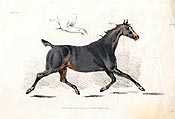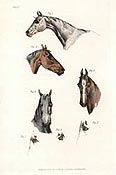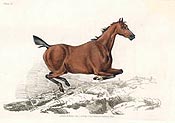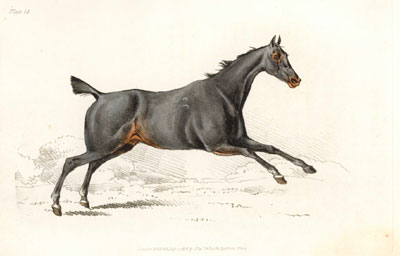|

Grey horse pictures

Composite horse pictures

Bay and chestnut horse pictures
|
Horse Pictures - Leaping
Antique pictures of
horses
|
The Beauties and Defects in the Figure of the Horse
Delineated in a Series of Coloured Plates
by H. Alken
Published in London by S. and J. Fuller at the
Temple of Fancy, 34 Rathbone Place
|
 |
|
Notes accompanying this plate
Leaping
The fall or pitch,
where there are double ditch fences, and fences
ditch from you, requires particular attention. It
appears to me, that more falls are occasioned by the
want of knowledge of this action of leaping, on the
part of the horse, than by any other description of
ignorance or mistake. As soon as the spring is made,
as mentioned in Plate XV, the hind legs should be so
thrown over the fence, as to give a fine purchase,
and the horse ought to appear to have almost the
power of retracting his leap, if necessary. This
shews confidence in the horse; and although I have
heard many sportsmen declare that this confidence
frequently tends to make the animal a short leaper,
from many circumstances which have come within my
own knowledge, I am clearly of opinion that the
assertion is not borne out by fact. In my judgement,
confidence will give the animal the power to direct
his fore-feet to any point he may desire, within his
compass; and for his own safety he will always cover
enough space, unless prevented by his rider, which
frequently occurs. In all cases where the leap is
difficult, so as to require skill and knowledge in
the horse, instead of courage or rashness, there
cannot be a doubt that the animal ought to be left
to his own discretion, without being fettered by any
supposed assistance on the part of the rider. |
|
The picture above is an
illustrated plate from the 1816 publication, the inside title page of which
is reproduced here along with the introduction to the book
 "By
a detailed series of graphic and descriptive illustrations, it is the
intention of the Author of this Work to show the good and bad points in
that most useful and noble animal the Horse. He has adopted the mode of
detaching various parts of the subject, because, by comparison of the
distinct appearances, the general impression upon the memory of the
reader is much likely to be much stronger than could result from the
study of any treatise of a less abstracted nature; to understand which,
a knowledge of anatomy, or a constant reference to some scientific work
is indispensable. "By
a detailed series of graphic and descriptive illustrations, it is the
intention of the Author of this Work to show the good and bad points in
that most useful and noble animal the Horse. He has adopted the mode of
detaching various parts of the subject, because, by comparison of the
distinct appearances, the general impression upon the memory of the
reader is much likely to be much stronger than could result from the
study of any treatise of a less abstracted nature; to understand which,
a knowledge of anatomy, or a constant reference to some scientific work
is indispensable.
This Publication is also intended as a
Book of Lessons for such young Artists as are inclined to pursue the
study of the Horse in all the different points of his figure and action.
There is no animal whose countenance
combines such correct and powerful expressions of character. The
physiognomy of the Horse, therefore, illustrating the different passions
to which he is subject, as well as the natural bias of his temper and
disposition, is an important branch of study to gentleman of the turf,
and to young purchasers; for it is generally considered, that to timid
riders and drivers, the temper of the beast is of more consequence than
any bodily blemish.
In this point of view, therefore, the
Author flatters himself that his Work will be found useful; and as his
remarks are the result of the most attentive observation during many
years, entirely devoted to the pleasures of the field, he trusts that
the general principles which he has laid down, as well with respect to
power, strength, and the various points of action as to the
physiognomical character and figure of the horse, will be found fairly
elucidated in the following series." |
|

